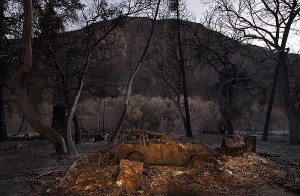Last week the Forest Service issued an updated closure order for the Station Fire burn areas of the Angeles National Forest. The closure order has been extended until 9/19/2011. Part of the Forest has been opened. Unfortunately, the newly re-opened section of the forest is limited to a small portion in the Sunland area. This is much less than most had hoped for, but includes areas around the Doc Larsen trail which CORBA trail crews worked on back in June and July.
Date: Sept. 17, 2010
ANF Release # 10-12
FOR IMMEDIATE RELEASE
Angeles National Forest
701 N. Santa Anita Avenue
Arcadia, CA 91006
www.fs.fed.us/r5/angeles
Contact: Sherry Rollman or
John D. Wagner at (626) 574-5208
Angeles National Forest reopens areas offering hiking, picnicking
ARCADIA, Calif.–Angeles National Forest will reopen an area about five miles long and two miles wide, northwest of Sunland, closed since the Station Fire last year.
The reopening of the Little Tujunga-Riverwood area is set for Monday (Sept. 20) and will offer the public recreation including picnicking and hiking. The area is being opened after trail improvements and storm-debris removal were completed.
The bulk of the forest’s burned areas remain closed for public safety, until further notice. “The Forest Service intent is to reopen areas severely damaged in the fire over the next few years as conditions allow,” said Jody Noiron, forest supervisor.
“We are developing a cohesive plan to create healthier, more sustainable ecosystems, involving water, vegetation and wildlife,” Noiron said. “We are making the hard decisions toward a healthier open-space for the L.A. basin in the future.”
Reopenings are taking place through a restoration plan, which engages the public on improving the health of the San Gabriel Mountains, and enlists volunteers.
The Forest Service invites volunteers, partners and others to help the forest with its natural resource conservation needs. If individuals or groups are interested in joining the efforts please visit our website at http://www.fs.fed.us/r5/angeles/.
The forest order for the pending reopening and an official map can also be viewed on the website.
Order No. 01-10-05
AREA CLOSURE
ANGELES NATIONAL FOREST
Pursuant to 16 USC 551 and 36 CFR 261.50(a) and (b), and to protect natural resources and provide for public
safety, the following acts are prohibited within the Station Fire Recovery Area of the Angeles National Forest. This
Order is effective from September 20, 2010, through September 19, 2011.
1. Going into or being upon National Forest System lands within the Station Fire Recovery Area, except
the Hidden Springs Day Use Area and Monte Cristo Campground. The Station Fire Recovery Area is
described in Exhibit A and shown on Exhibit B. 36 CFR 261.53(e).
2. Being on any National Forest System road within the Station Fire Recovery Area, which is described in
Exhibit A and shown on Exhibit B. 36 CFR 261.54(e).
3. Being on any National Forest System trail within the Station Fire Recovery Area, which is described in
Exhibit A and shown on Exhibit B. 36 CFR 261.55(a).
Pursuant to 36 CFR 261.50(e), the following persons are exempt from this Order:
1. Persons with a permit from the Forest Service specifically authorizing the otherwise prohibited act or
omission.
2. Owners or lessees of private land within the Station Fire Recovery Area are exempt from the prohibitions
listed above to the extent necessary to gain access to their land.
3. Persons who reside on private land within the Station Fire Recovery Area are exempt from the prohibitions
listed above to the extent necessary to gain access to their residences.
4. Persons with a special use permit or contract from the Forest Service authorizing work within the Station
Fire Recovery Area and their employees, sub-contractors, or agents are exempt from the prohibitions listed
above to the extent authorized by the special use permit or contract.
5. Any Federal, State, or local officer, or member of an organized rescue or fire fighting force in the
performance of an official duty.





![55156097[1]](http://173.83.181.116/news/wp-content/uploads/2010/07/551560971-300x294.jpg)

